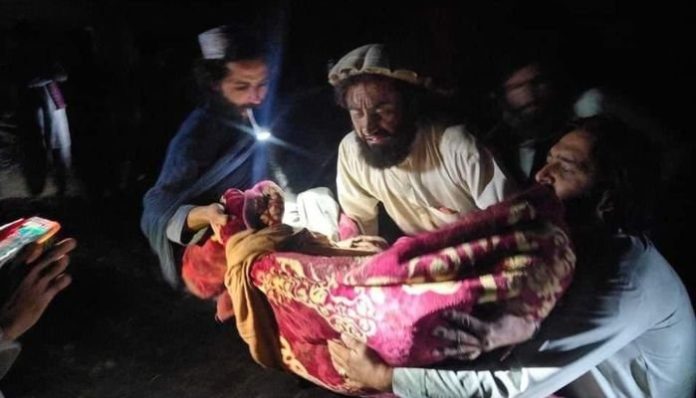KABUL: The death toll from an earthquake in Afghanistan on Wednesday hit 1,000, disaster management officials said, with more than 600 injured, and the toll is expected to grow as information trickles in from remote mountain villages.
Houses were reduced to rubble and bodies swathed in blankets lay on the ground after the magnitude 6.1 earthquake, photographs on Afghan media showed.
Health and aid workers said an unknown number of people remained stuck under rubble and in outlying areas, and rescue operations were complicated by difficult conditions, including heavy rains, landslides, and many villages being nestled in inaccessible hillside areas.
“Many people are still buried under the soil.” The rescue teams of the Islamic Emirate have arrived and, with the help of local people, are trying to take out the dead and injured, “a health worker at a hospital in the hard-hit Paktika province said, asking for anonymity as he was not authorised to speak to media.
Mounting a rescue operation will prove a major test for the Taliban authorities, who took over the country last August after two decades of war and have been cut off from much international assistance because of sanctions. The Taliban-led ministry of defence is leading rescue efforts.
Loretta Hieber Girardet, from the United Nations’ disaster risk reduction office, said efforts to provide relief and save people trapped under rubble would face huge challenges due to the terrain and weather.
“The roads are poor even at the best of times, so having a humanitarian operation put in place is going to be immediately challenged by the lack of easy access to the area,” she said, adding that rain combined with the tremor created a further risk of landslides for humanitarian workers.
The UN office for humanitarian aid said it would send medical teams and give medical supplies.
Interior ministry official Salahuddin Ayubi said the death toll was likely to rise “as some of the villages are in remote areas in the mountains and it will take some time to collect details.”
Wednesday’s quake was the deadliest in Afghanistan since 2002. It struck about 44 km (27 miles) from the southeastern city of Khost, near the border with Pakistan, the US Geological Survey (USGS) said.
Shaking was felt by about 119 million people in Pakistan, Afghanistan, and India, the European-Mediterranean Seismological Centre (EMSC) said on Twitter, but there were no immediate reports of damage or casualties in Pakistan.
The EMSC put the earthquake’s magnitude at 6.1, though the USGC said it was 5.9.
Disaster experts and aid workers said that the hilly areas that were poor and hit by the earthquake were especially at risk because of landslides and poorly built homes.
“We were all sleeping at home… and the room fell over us,” said Gul Faraz as he received treatment for injuries with his wife and children at a hospital in Paktika. Some family members had been killed, he said.
“All the houses in our area were destroyed, not one, but the entire region has been destroyed.”
Most of the confirmed deaths were in the eastern province of Paktika, where 255 people were killed and more than 200 injured, Ayubi said. In the province of Khost, 25 were dead and 90 had been taken to hospital.
Recent flooding in many regions has added to the difficulty for Afghan authorities, causing stretches of highway to be closed.
Afghanistan is also grappling with a severe economic crisis. Last year, when the Taliban took over, many countries put restrictions on Afghanistan’s banks and cut billions of dollars in development aid.
Humanitarian aid has continued, however, from international agencies such as the United Nations.
A foreign ministry spokesman said the Taliban would welcome international help.
US President Joe Biden directed the US Agency for International Development and other federal government partners to assess US response options, the White House said.
UN Secretary-General Antonio Guterres said the United Nations was fully mobilized, assessing the needs and providing initial support.
“We count on the international community to help support the hundreds of families hit by this latest disaster. Now is the time for solidarity,” he said in a statement.
Large parts of South Asia are seismically active because a tectonic plate known as the Indian plate is pushing north into the Eurasian plate.
In 2015, an earthquake struck the remote Afghan northeast, killing several hundred people in Afghanistan and nearby northern Pakistan.
The Japanese government plans to provide assistance to Afghanistan, a government spokesperson said on Thursday, after an earthquake there killed at least 1,000 people.
Deputy Chief Cabinet Secretary Seiji Kihara told a regular news conference that the government was coordinating moves to “provide necessary support promptly” as well as assessing the situation to grasp local needs.
The US State Department said it was not aware of any request for American assistance from Afghanistan’s Taliban government after an earthquake there on Wednesday that killed at least 1,000 people.
The United States expects the humanitarian response to the disaster to be a topic of conversation between Taliban and US officials in the coming days, State Department spokesperson Ned Price told reporters.

















